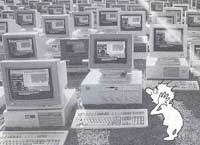BBC dreams about the machine
 WHAT SETS the BBC apart from other TV networks is the kind of subjects it chooses for its documentaries and the quality research it puts into bringing alive subjects that are considered unexciting by most commercial networks. Two very different kinds of series on computers -- Computing for the Terrified and The Dream Machine -- are examples of BBC's skill.
WHAT SETS the BBC apart from other TV networks is the kind of subjects it chooses for its documentaries and the quality research it puts into bringing alive subjects that are considered unexciting by most commercial networks. Two very different kinds of series on computers -- Computing for the Terrified and The Dream Machine -- are examples of BBC's skill.
Computing for the Terrified is a drama series, which demonstrates the large role computers play in everyday Western life. When Helen who has a phobia about technology in general and computers in particular, takes in a lodger, Sally, who is an efficient logged-on computer journalist, there are some initial sparks, but eventually more organisation, in Helen's chaotic life.
By following Sally's reporting assignments, the viewer gets a glimpse of how integral computers are to the functioning of, say, a Western supermarket: Which stocks are moving fastest and will need replacing first, and how suppliers check into an electronic mail system to get their orders. Helen, meanwhile, is being slowly initiated into using a personal computer to keep her tax records in order.
But the series has too English a flavour to cut much ice with Indian viewers, and Helen's accent is a major impediment in understanding it.
From evolution onwards The Dream Machine is a documentary series that traces the evolution of the computer. Starting with the visionary Charles Babbage, the Englishman who invented an early calculating machine, it tells its story through the humans who produced the machines that have changed the world. Lord Byron's daughter, Aida, you discover, was the world's first computer programmer. From the room-sized number cruncher ENLAC, which in 1946, was the world's first electronic computer, you are taken through the many stages of evolution (and excitement) that the dream machine went through to become the compact super-brain of today.
The series uses a combination of archive material, including dramatised sequences and interviews with computer pioneers, scientists and entrepreneurs to tell its story. You meet Doug Engelbart who invented the mouse, and are taken to the Homebrewed Computer Club, which was set up in San Francisco in 1976, and from where emerged "two scruffy fellows with circuit boards" -- Steve Job and Stephen Wozniak, fathers of the personal computer. Before long, each of them was richer by $100 million, and their baby, Apple Computers, was the fastest growing computer company in the world.
The series gets across all the drama of invention and its successful marketing. While the Apple saga was unfolding, IBM was sitting quietly on the sidelines, watching. In 1981, it introduced what is described as a "serious personal computer". Three years later, it was threatening to take on Apple in its bid to control the world computer market. Apple then brought out a controversial advertisement portraying IBM as Big Brother, as in the Orwellian saga. It was, after all, the year 1984.
The simultaneous developments in user-friendly software are also chronicled, from the work being done by Xerox, to Mitchel Kapor's invention, Lotus. The Dream Machine is definitely the sort of series that schools and colleges should have copies of in their library, for their students to watch.
Dinosaur ancestors In the first week of November, Star TV ran a fascinating documentary, The Dinosaurs, presented by former CBS TV anchorperson Walter Cronkite. Was the dinosaur the ancestor of today's bird? The film explores the similarities between the body structure of the dinosaur and that of today's birds, and the even greater similarities that both the bird and the dinosaur had with a now extinct creature, which forms the missing link between the two. Much of the film, however, is devoted to examining evidence on the newest and most intriguing hypothesis on how dinosaurs became extinct: A giant asteroid struck the earth 65 million years ago, wiping out a species that had existed for 140 million years.
